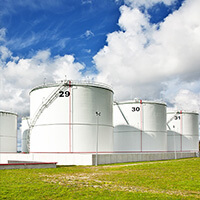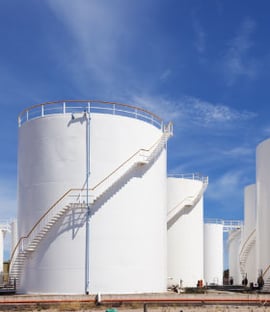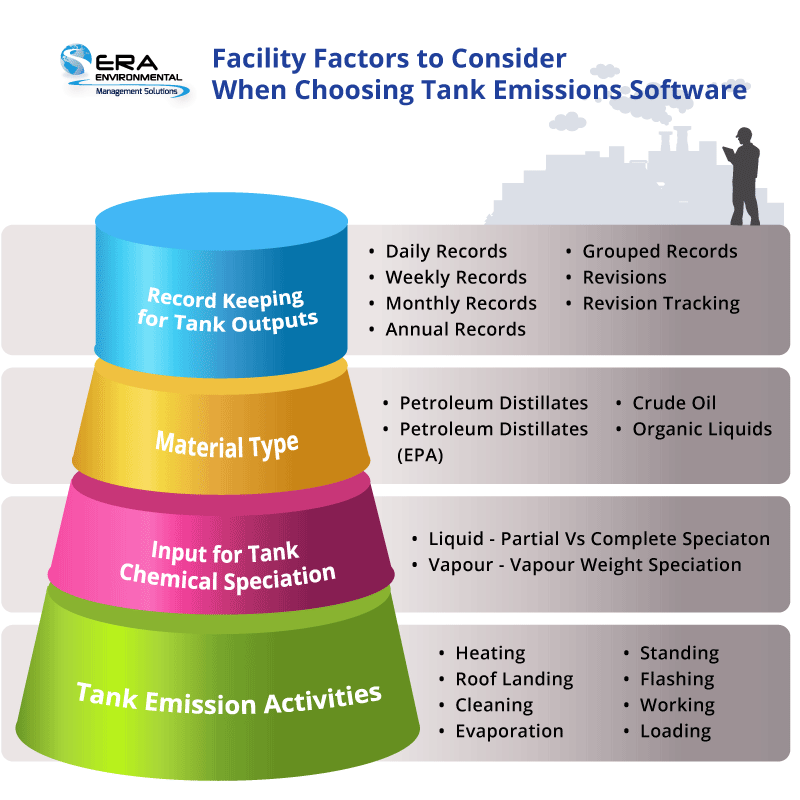
Having a Tank Emissions Software that encompasses emissions from your facility's specific tank types and tank events is an underestimated advantage for environmental reporting. It makes performing AP-42 calculations infinitely easier.
Having tank emissions software also helps you to standardize your data collection across facilities and stay on top of emissions thresholds before it is too late. Having the ability to calculate emissions from all chemicals including blends or mixtures is a benefit many manufacturers enjoy taking advantage of.
This article will outline what you need to know before choosing a tank emissions software, from knowing the type of tanks you use to all the industrial processes you are involved in.
To make the right decision when you are choosing a tanks emissions software, answer these four questions;
- Can the software handle automated upload of tank throughput data from your internal systems and ERP software?
- Does the software have full revision tracking for both changes in processes and formulas?
- Does the software have the most up-to-date calculation methodologies and regulatory flags?
- Can the software handle loading losses and other tank-specific processes?
We recommend that you thoroughly check if your prospective tank emissions software solutions address your specific requirements.
What Type of Process do You Perform at Your Facility?Not all businesses use tanks in the same way. Each process shifts and affects the calculation methodology significantly, so it is an excellent consideration when choosing the software.
Process types range from oil exploration, midstream activities, chemical manufacturing plants, and industrial manufacturing. All these process types involve a variety of practices and materials that must be included in emission tracking.
- Oil exploration involves crude oil, water, dehydrators, and gas lines, showing various emission points during the process.
- Crude oil refining includes distillation storage, mixing, packaging, and loading. OIl exploration includes working losses from splash loading and submerged loading.
- Midstream activities are a significant component of oil and gas industry operations. These include processes for storing transporting oil, gas liquids, and natural gas. Examples of midstream activity tanks include mix tanks, tank trucks, and other processing tanks.
If your facility is a chemical plant, more storage is required, which means there will be tank farms and storage and mixing tanks present in your operations. The last industry or process type that you may be a part of is industry or manufacturing processes that require tanks for oil and gas storage, such as automotive supplies.
What Type of Tanks Do You Have on Your Facility?
 The processes mentioned above utilize different types of tanks depending on the function and quantity of the chemical/material in use. These include open-top, horizontal, vertical fixed roof, internal floating roof, external floating roof, domed external floating roof tanks, and many more.
The processes mentioned above utilize different types of tanks depending on the function and quantity of the chemical/material in use. These include open-top, horizontal, vertical fixed roof, internal floating roof, external floating roof, domed external floating roof tanks, and many more.
It is essential to specify your tank type when searching for a software solution because of the difference in tank sizes and orientations when performing tank calculations. For example, in oil exploration plants, fixed roof tanks, and floating roof tanks are more popular in chemical plants. This means that if you are in the oil exploration industry, you must record emissions from floating roof tanks. Emissions vary according to industry.
All these are subject to regulations that change frequently; therefore, ensure that your chosen software has frequently updated regulatory information to match your specific tank parameters, processes, and chemicals.
What Information Do I need to Calculate Tank Emissions Accurately?
The calculations involve the tank roof type and other tank parameters such as size and location, which is the geographical location of the tank.
The type of material stored in the tank is a significant consideration. Some facilities store organic liquids such as toluene, benzene, petroleum distillates, crude oil, and pure compounds. Your chosen software should store the product specifications for both unprocessed and processed states of your products, including different blends stored in various tanks.
You also need full revision tracking to allow for accurate updates when changes arise in your process.
Does the Tank Emissions Software Have Automatic Import Systems?
Automatic data import makes for an efficient AP-42 air emissions recording system. Automated upload of tank throughput data reduces the need for manual data entry, which is prone to errors. However, you must make sure that your chosen software provides both options in case of a faulty upload that needs manual collection or any missed records from devices monitored manually. It should also have reminders and regulatory flags when approaching the emissions threshold.
Do You Trust the Scientific Methodology Used?
Some EPA tank emission calculation methods or tools only calculate certain situations such as organic mixtures (AP-42 chapter 6), petroleum (AP-42 Chapter 5), crude oil, asphalt, and pure substances. The different approaches include various AP-42 calculations or American petroleum institute and API equations and lab-tested data for chemical speciation.
You can use emission calculation formulae to deduce tank emissions. These include volatile organic compounds (VOC) and particulate matter (PM). Two extra calculation factors apart from tank type and other parameters are control devices and stacks associated with your type of chemical process.
The control device refers to the device that captures emissions out of the stacks and controls the percentage that is being emitted to the atmosphere tanks, for example, a flare. Stack or emission point refers to the location on the tanks through which emissions are released out.
Make sure that the calculation method takes these into account accurately before committing to the software solutions.
Do You Need Capability for Hot & Heated Tanks or Other Special Cases?
The final evaluation is checking if you have any special cases for your tanks. Having hot or heated tanks is an example of a particular case. People often assume that the insulation from heated tanks prevents emissions, but you must also consider if the tank is only partially or fully insulated. This means more evaluation on how the emissions calculations should be made. Capabilities should also cover loading losses
Below is a summary diagram of the functionality that your software should consider.

To learn more about ERA’s Tank Management Software, schedule a complimentary Discovery Call with a project analyst to discuss your tanks processes/reporting requirements and how ERA’s solution can help.
Want to learn more about tank emission software for your business? Check out the free resources below:
This Blog Was Co-Authored By:


Tags:
EHS Software
December 9, 2015

Comments